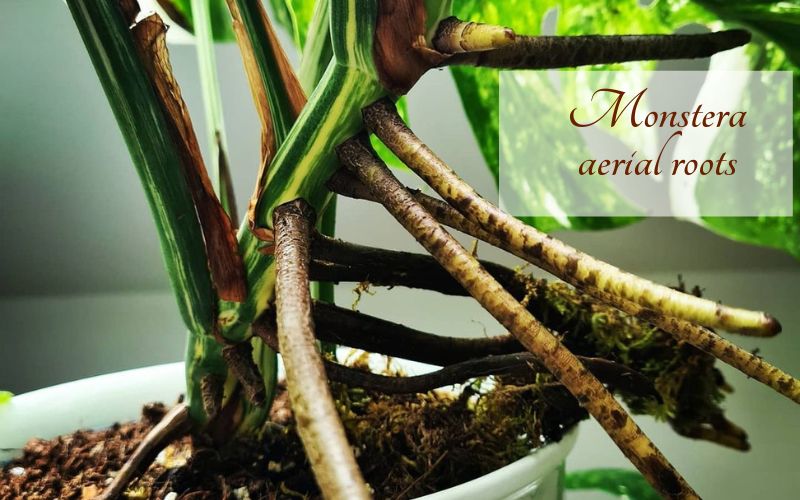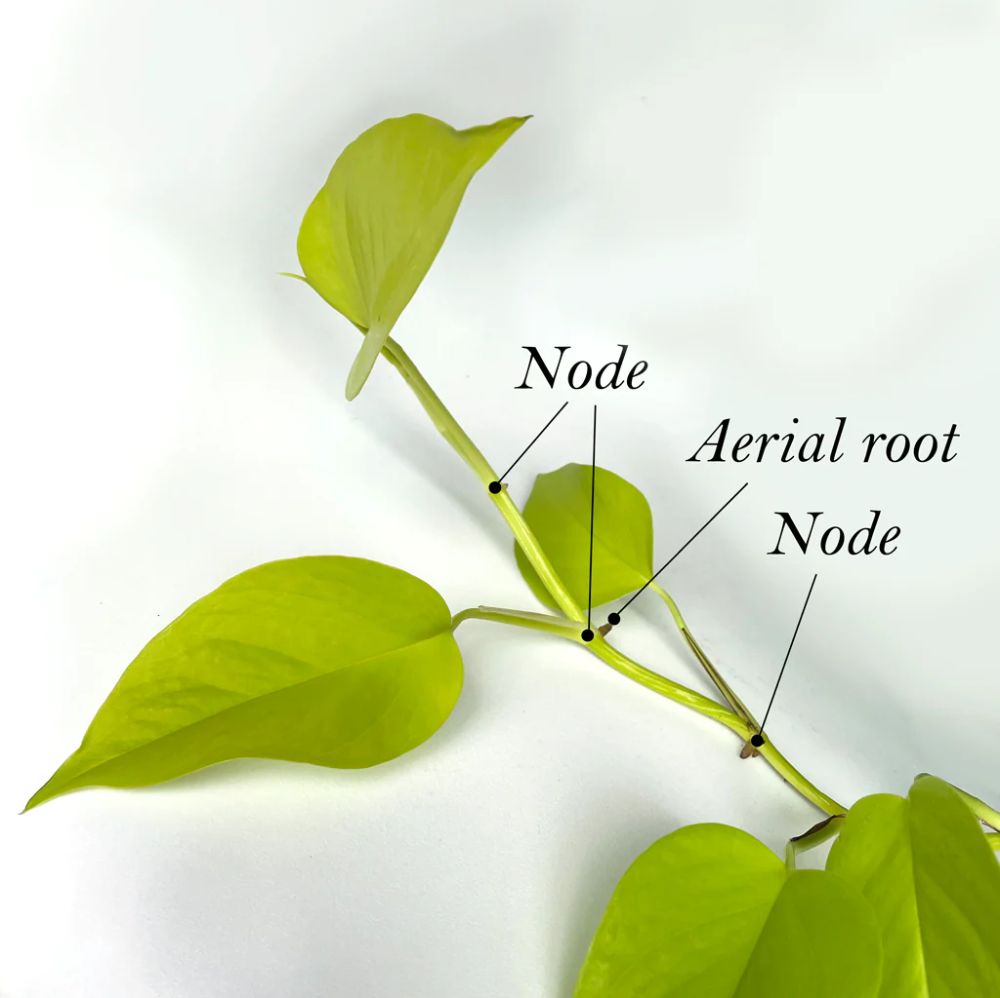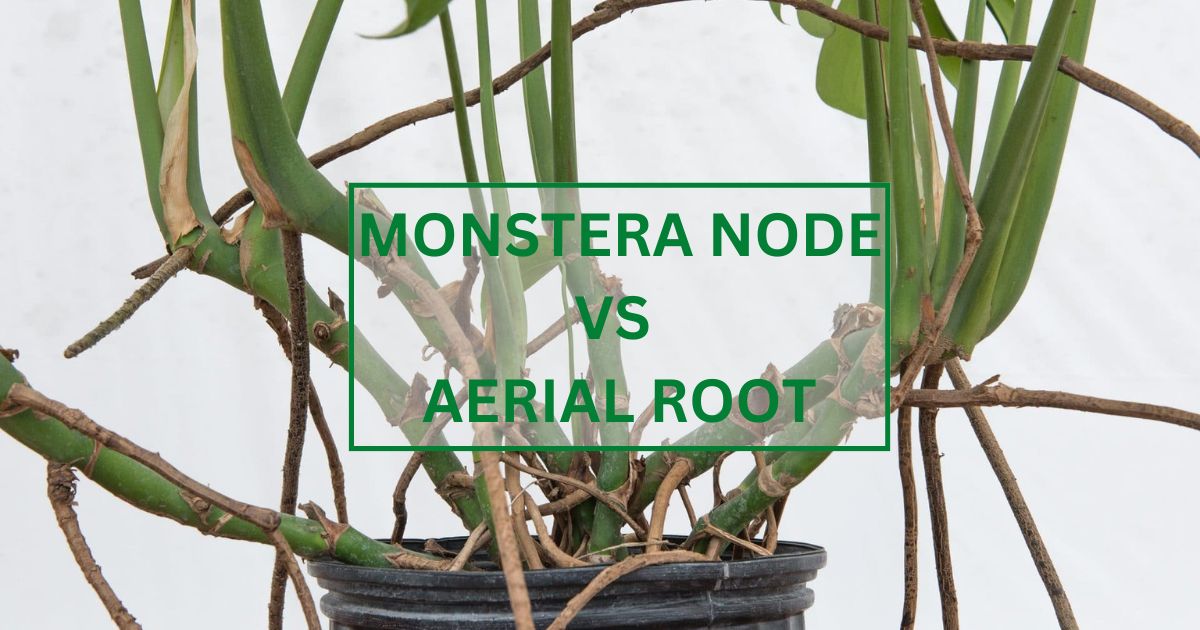When I first dived into the amazing world of houseplants, I found myself really amazed by one cool plant: the Monstera Deliciosa. The Monstera, with its cool leaves and tropical charm, instantly became my fav. However, I realized there was a lot more to this plant than met the eye. Really interesting were the terms “Monstera Node” and “Monstera Aerial Root”. As I started figuring out the plant, understanding the difference between a Monstera Node vs Aerial Root became key in successfully growing and caring for this cool plant. I’m excited to share my findings, hoping to make your journey with the Monstera a delightful one.
What is a Monstera Node?
Monstera Nodes may at first seem confusing, but they play an important role in the plant’s anatomy and growth. Basically, a node is the main spot on the stem of your Monstera plant from where all new growth – leaves, stems, petioles, and even aerial roots – starts. Monstera nodes are super important for propagation and for the overall growth and plant’s health.
- Propagation: When you propagate a Monstera plant from a stem cutting, you need to make sure that the cutting includes at least one node. This is because the node contains the meristematic tissue, which is the tissue responsible for new growth. If the cutting does not include a node, it will not be able to propagate.
- Growing: Monstera nodes are also essential for the overall growth and health of the plant. Nodes are where new leaves, stems, and aerial roots grow out. Without nodes, the plant would not be able to grow and spread.

Now, how do you find a node? If you take a closer look at your Monstera stem, you will typically see tiny bumps on the opposite side of the stem from a leaf. These bumps are named nodes. Odes are typically located at the base of a leaf stem, on the opposite side of the stem from just the leaf. Nodes may be visible as small bumps on the stem.
Understanding the concept of a node is essential for propagation. When you decide to make more of the beauty of your Monstera through propagation, make sure that the cutting includes at least one node, as this is essential for new growth, enabling the cutting to grow new roots and leaves. Nodes can produce new leaves, stems, aerial roots, and even flowers.
In summary, the Monstera node is a key part of your plant’s structure, shaping its growth and ability to spread. The more you get to know it, the better you will get at caring for your Monstera.
What is an Aerial Root?
Monstera aerial roots are a cool feature that sets this plant apart from many others. These roots shoot upwards, growing above the ground level, showing a super cool adjustment to their environment. Aerial roots are roots that grow on the stems of certain plants, above the soil. In the wild, monsteras use their aerial roots to climb trees and other surfaces, allowing them to reach more sunlight. At home, monstera aerial roots can be trained to climb moss poles or other supports, which can help the plant grow taller and stronger.
In their home ground, Monsteras are climbing plants, climbing trees to catch some sun. The aerial roots act like nature’s climbers, helping Monsteras to stick to things and climb high. More than just handy support, these roots also have the fascinating ability to soak up water and food straight from the air, boosting the plant’s food uptake.
Aerial roots are also found on other types of plants, such as epiphytes (plants that grow on other plants) and tropical swamp trees. Epiphytes use their aerial roots to attach themselves to their host plants, while tropical swamp trees use their aerial roots to breathe in fresh air from above the waterlogged soil.

Aerial roots help Monsteras absorb water and food from the air in the following ways:
- Spongy outer layer: The outer layer of aerial roots is spongy and can absorb moisture from the air.
Special cells: Aerial roots also have special cells called velamen that can absorb nutrients from the air, such as nitrogen. - Increased surface area: Aerial roots have a large surface area, which allows them to absorb more water and nutrients from the air.
When aerial roots come into contact with a damp spot, such as a moss pole or tree trunk, they can absorb water and nutrients directly from the surface. This is especially beneficial for Monsteras that are growing in dry places.
In addition to absorbing water and nutrients, aerial roots also help to support Monsteras as they grow. When aerial roots attach to a surface, they provide the plant with additional support, which can help to prevent it from falling over.
Here is a more detailed explanation of how aerial roots absorb water and nutrients from the air:
- The spongy outer layer of aerial roots absorbs moisture from the air.
- The velamen cells absorb nutrients from the air, such as nitrogen.
- The water and nutrients are then transported through the aerial roots to the rest of the plant.
This process is called aerial absorption. Aerial absorption is especially important for Monsteras that are growing in low-humidity environments, as it allows them to obtain water and nutrients even when the air is dry.
In a nutshell, a Monstera aerial root is not just a fascinating bit to look at, but proof of the plant’s cool changes and tricks to survive. Aerial roots do not need to be buried in the soil, but they can be misted with water regularly to help them stay moist. It’s one of the many reasons why Monsteras keep wowing plant lovers worldwide.
The Difference Between Monstera Nodes and Aerial Roots
As we explore the fascinating world of Monstera plants, we encounter many interesting features, each with its own unique function. Two key parts of a Monstera plant are nodes and aerial roots. While they are similar in some ways, they are also different in terms of their location, appearance, and function.
| The Difference Between Monstera Nodes and Aerial Roots | Monstera Nodes | Monstera Aerial Roots |
| Location | Along the Monstera stem | Grow out from the stem |
| Appearance | Little bumps | Thin, green roots |
| Function | Growth hotspots where new leaves, branches, petioles, and even aerial roots start | Support the plant and absorb water and nutrients from the air |

First, let’s think about where they are. Nodes are along the Monstera stem, showing up as little bumps. Aerial roots grow out from the stem, reaching out into the air instead of just sticking to the stem’s surface.
Nodes usually stick out more than aerial roots, adding to their visual difference. But, it’s what they do that really makes them unique.
Nodes are the plant’s growth hotspots. These are the important spots where new leaves, branches, petioles, and even aerial roots start. A node is where growth begins, so it’s a key spot to know when you want to propagate.
Aerial roots, but, do two things – they keep the plant steady and watered. They grow from the stem and keep the plant steady on a support, making sure the Monstera doesn’t tip over as it grows. Plus, they take in water from the air, adding to the plant’s water intake and making sure it stays healthy.
Why are Nodes and Aerial Roots Important for Monstera Plants?
Both nodes and aerial roots have super important jobs in a Monstera plant’s life, each chipping in their own way to the plant’s health and happiness. Getting why they’re important can help you better look after and propagate your Monstera.
Nodes, to start, are where new stuff grows. They’re where new leaves, stems, petioles, and even aerial roots begin. When propagating, nodes play a major part. When you take a cutting of a Monstera, making sure there’s at least one node is super important. This node is the life-bringer for your cutting, making it grow new roots and leaves, and eventually become a new plant.
Aerial roots, on the flip side, help out a lot for Monsteras in pots. They’re like the plant’s seatbelt, latching onto supports to keep it steady. But, they do more than just hold it up. Aerial roots have an awesome skill to take in water from the air, adding to the water needs of the plant. In indoor settings where soil water might not be perfect, aerial roots step in to keep the plant watered and healthy.
How to Care for Monstera Nodes and Aerial Roots
Looking after your Monstera’s nodes and aerial roots doesn’t have to be a tough job. With the right amount of water, sunlight, and the right pot for your monstera, you can make sure these important bits are happy, which helps your Monstera’s overall health.
When I first started looking after my Monstera, I learned that regular watering is key. I try to water my potted Monstera often, but how often depends on the plant’s size and the local weather. My general guideline is to wait until the soil feels dry before watering again. This way, I’m not watering too much, which could lead to root rot and other issues.
Sunlight is another super important thing. Monsteras love bright, indirect sunlight. They’re a bit like Goldilocks – not too much, not too little, but just the right amount of light. Direct sunlight can burn their beautiful leaves, so I prefer to put my Monstera somewhere with lots of indirect sunlight.
The right pot can also make a big difference to your Monstera’s nodes and aerial roots. A pot that’s too small can limit growth, while one that’s too big can hold too much water and maybe cause root rot. I find that a pot that’s the right size for my Monstera helps promote healthy growth and avoid possible problems.
And, don’t forget about your Monstera’s aerial roots. If they start to look too dry, giving them a spray of water can help keep them watered.
So, getting the hang of the difference between Monstera nodes and aerial roots is super important in keeping up your plant’s health and boosting its growth. By giving the right balance of care, you can make sure these key parts do well. Don’t forget, every Monstera’s path to being healthy starts at its nodes and goes through its aerial roots. For more cool tips and plant care advice, visit us at FamiPlants. Show off your green thumb!

